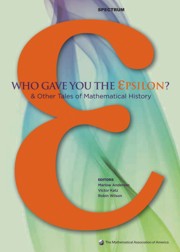Book contents
- Frontmatter
- Introduction
- Contents
- Analysis
- Foreword
- Who Gave You the Epsilon? Cauchy and the Origins of Rigorous Calculus
- Evolution of the Function Concept: A Brief Survey
- S. Kovalevsky: A Mathematical Lesson
- Highlights in the History of Spectral Theory
- Alan Turing and the Central Limit Theorem
- Why did George Green Write his Essay of 1828 on Electricity and Magnetism?
- Connectivity and Smoke-Rings: Green's Second Identity in its First Fifty Years
- The History of Stokes' Theorem
- The Mathematical Collaboration of M. L. Cartwright and J. E. Littlewood
- Dr. David Harold Blackwell, African American Pioneer
- Afterword
- Geometry, Topology and Foundations
- Algebra and Number Theory
- Surveys
- Index
- About the Editors
Afterword
from Analysis
- Frontmatter
- Introduction
- Contents
- Analysis
- Foreword
- Who Gave You the Epsilon? Cauchy and the Origins of Rigorous Calculus
- Evolution of the Function Concept: A Brief Survey
- S. Kovalevsky: A Mathematical Lesson
- Highlights in the History of Spectral Theory
- Alan Turing and the Central Limit Theorem
- Why did George Green Write his Essay of 1828 on Electricity and Magnetism?
- Connectivity and Smoke-Rings: Green's Second Identity in its First Fifty Years
- The History of Stokes' Theorem
- The Mathematical Collaboration of M. L. Cartwright and J. E. Littlewood
- Dr. David Harold Blackwell, African American Pioneer
- Afterword
- Geometry, Topology and Foundations
- Algebra and Number Theory
- Surveys
- Index
- About the Editors
Summary
For more details on the work of Cauchy, the best book is Judith Grabiner's own work, The Origins of Cauchy's Rigorous Calculus [8]. A slightly more recent work on nineteenth-century analysis in general is Umberto Bottazzini, The Higher Calculus: A History of Real and Complex Analysis from Euler to Weierstrass [1].
It is interesting to compare Cauchy's work with the contemporary work of Bolzano. Bolzano's important paper on the intermediate value theorem is available in [17], while [18] is the complete collection of his mathematical works. For more discussion of the work of Bolzano, see I. Grattan-Guinness [9]. Grattan-Guinness claims that Cauchy took the central ideas of his definitions of continuity and convergence from Bolzano. But H. Freudenthal and H. Sinaceur disagree [7], [19]. In particular, the latter article claims that Bolzano and Cauchy represented two different mathematical traditions.
It is also interesting that Cauchy's definition of convergence had been essentially given by José Anastácio da Cunha (1744–1787), a Portuguese scholar, in a comprehensive textbook written in Portuguese in 1782. Unfortunately, even though the book was translated into French in 1811, it apparently was little noticed. For more on da Cunha, see the articles A. J. Franco de Oliveira [6], João Filipe Queiró [16], and A. P. Youschkevitch [21].
Near the beginning of his article on functions, Kleiner notes that there was a long “prehistory” of functions, but does not discuss this at all.
- Type
- Chapter
- Information
- Who Gave You the Epsilon?And Other Tales of Mathematical History, pp. 109 - 110Publisher: Mathematical Association of AmericaPrint publication year: 2009

